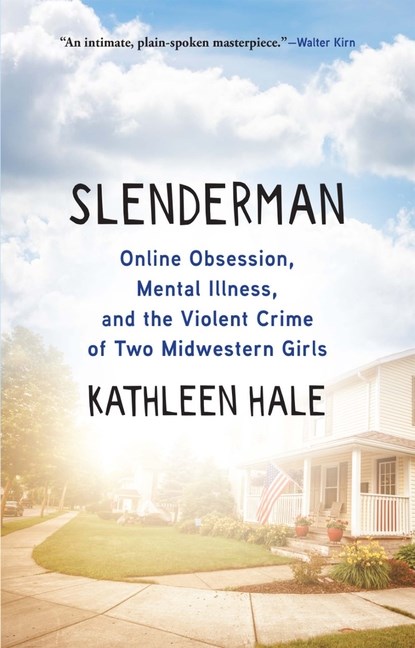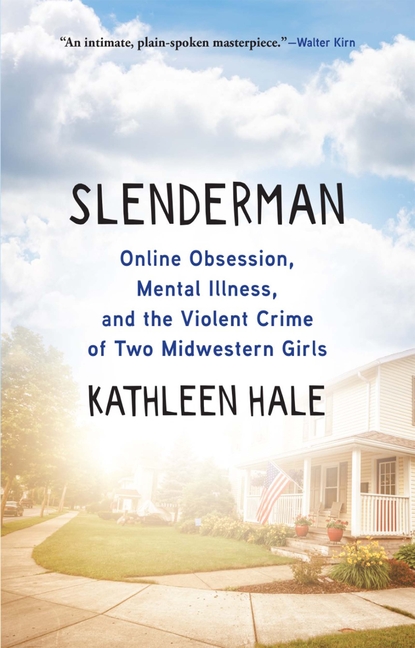Slenderman: Online Obsession, Mental Illness, and the Violent Crime of Two Midwestern Girls
August 18, 2022
Kathleen Hale’s comprehensive narrative of the Slenderman stabbing case is a cautionary tale for us all, illustrating how denying the existence of a problem doesn’t make it go away—it only shifts the burden of who must deal with it, often to vulnerable people without the full capacity to handle it.
Slenderman: Online Obsession, Mental Illness, and the Violent Crime of Two Midwestern Girls by Kathleen Hale, Grove Press
On May 31, 2014, two twelve-year-old girls—Morgan Geyser and Anissa Weier—lured their friend, Payton “Bella” Leutner, into a nearby wooded area and stabbed her nineteen times. The girls’ reasoning, they later revealed, was a need to appease Slenderman, a fictional entity they believed to be a genuine threat to the safety of their families. Morgan and Anissa were detained while attempting to hike out of the city, while Bella, after dragging herself out of the woods and encountering a nearby cyclist, miraculously survived her injuries.
Here in Milwaukee, news of the Slenderman stabbing case in Waukesha filled our local headlines for years. It’s a story that everyone in the area seems to know the broad strokes of, but beyond the initial morbid curiosity, interest in the case has largely faded. By February 2018, Morgan and Anissa had both been tried and sentenced. Updates on the case still appear in the papers, but no longer with the same splash as before. During a recent conversation, when I brought up that I was reading a book about the case, I encountered a strange dismissiveness, as if there was nothing more to say about the story because we already know it so well.
But do we?
If there is any one lesson to be drawn from Kathleen Hale’s new book, it’s that a failure to seek answers can lead to tragic results. Slenderman is one of the first deep dives into the story of the girls behind the Slenderman stabbing case. Having previously written about the case for Vice and Hazlitt, Hale spent seven years piecing together the narrative from public records and direct interviews with Morgan Geyser, one of the defendants in the case. The book aims to give a complete picture of the girls’ lives leading up to stabbing, as well as the aftermath in which they navigate Wisconsin’s criminal justice system.
I won’t try to summarize the full narrative of the book, because presenting key events without their full context risks misinterpretation, which this case and the people involved in it have already been repeatedly subjected to. Slenderman is a book that asks its readers to approach difficult, stigmatizing subjects—mental illness and criminal justice—with an open mind. Watching the story unfold and knowing the fate that everyone involved is heading towards often had my pulse racing. Hale doesn’t sensationalize the case; rather, the story is treated with care, and while I came away feeling far more empathy towards the Geyser, Weier, and Leutner families, I also found myself dismayed about the ways our society can fail its children.
In the opening Author’s Note, Hale notes the difficulty she encountered in obtaining the public records associated to the case, with transcripts from the Waukesha County Courthouse costing nearly five dollars per page, and with legal documents often kept not in the courthouse records office, but by the court reporters who took down the original notes. Already, there are systemic barriers in trying to recount a story that, theoretically, should be publicly accessible. Hale writes (emphasis mine):
Perhaps as a result of the steep cost of obtaining documents, previous reporting on this case has often been erroneous, and much of what is contained in these pages has not been published until now. Many people who think they know about the Slenderman stabbing, for instance, believe that Bella is dead—a misapprehension that persists so strongly to this day that even the judge on Morgan and Anissa’s case has mistakenly referred to their crime as “intentional homicide” rather than attempted murder. Early reporting on the stabbing also excluded any mention of Morgan’s schizophrenia, except for in rare cases where journalists derided it as an attempt by her lawyers to manipulate the law. So far the media has told a story of two unrepentant, violent criminals possessed by an internet demon. This is what really happened.
The overarching theme of the narrative is how, in the lead-up to the stabbing, the adults in Morgan, Anissa, and Bella’s lives—and the systems meant to protect them—misinterpreted warning signs of mental illness and maladaptive behavior as typical preteen nonsense. Because the adults failed to look beyond the surface, the three young girls are largely left to fend for themselves and seek answers to real-life problems in fictional stories, resulting in tragic consequences for everyone involved.
Morgan, who had begun experiencing hallucinations when she was a toddler, asks her father Matt—who is living with diagnosed but unmedicated schizophrenia—to explain what’s going on. Coming from a conservative and religious family, Matt did not grow up in a space where mental illness was discussed openly. Likewise, he pushes off the conversation with his daughter, promising he’ll tell her everything when she turns sixteen (“an arbitrary number,” Morgan later says). Morgan’s mother, Angie, a healthcare worker who works long shifts that keep her away from home, chalks her daughter’s symptoms up to migraines, unaware that Morgan had a one-in-ten chance of inheriting her father’s schizophrenia. Yet by the time she reaches middle school, Morgan is spending her waking hours surrounded by a coterie of characters visible only to her, including one that appears to be “the silhouette of a man […] a towering, shadowy thing, shifting in and out of corners, his body the color of smoke and ink.”
Anissa enters middle school just as her parents are finalizing their divorce. Her older half-siblings from her father’s prior marriage are dealing with the impending death of their mother, and so Anissa keeps to herself, hoping her father will appreciate her efforts to take up as little of his attention as possible. In the moments she expresses sadness about her parents’ divorce and the loneliness associated with being the new kid at school, her father fails to meaningfully engage with her, believing she’ll get over it as time goes on. She takes refuge in video games and soon discovers Creepypasta.com, an online collection of amateur horror stories featuring a rotating cast of characters including Slenderman: “a man with extremely long, slender arms and legs [that] also appears to have 4 to 8 long, black tentacles that protrude from his back.” Because of the trove of “evidence” proving Slenderman’s existence (usually images stemming from Photoshop contests), “young Anissa read the ‘true stories’ as if they were entries on Wikipedia, filing away every detail of Creepypasta mythology as real.”
Of the three girls, Bella appears to grow up in the most stable household. She befriends Morgan in the fourth grade out of a sense that no one should be friendless, and she pretends to see Morgan’s hallucinations to help her feel less lonely.
When Morgan and Anissa become friends and begin obsessing over the Creepypasta urban legends, Morgan’s parents attribute her fixation to typical preteen behavior, not realizing that the stories are inadvertently confirming Morgan’s hallucinations as reality. Anissa’s father trusts in the fact that the girls are accessing the website through a firewalled, school-issued iPad, and therefore has nothing to worry about. Bella’s mother, Stacie, is the only one who proactively sits Bella down in front of the computer to reassure her that the stories are fiction. However, as Morgan’s behavior becomes increasingly erratic—Morgan and Bella start a minor fire in the Leutner basement, which Morgan then denies any knowledge of—Stacie opts to avoid confrontation with Morgan’s parents and says nothing about the incident, despite her concerns that Morgan is becoming a “bad influence.”
The warning signs don’t go completely unnoticed. The girls’ classmates notice their increasingly strange behavior and often report it—one student speaks up when Morgan brings a rubber mallet to school; another witnesses Morgan write the word “die” repeatedly in her notebook; yet another catches Morgan self-harming during math class—but school staff brush the behavior off as “quirky.” As Hale notes,
Even the student who reported Morgan for the “sledgehammer” would be written off by Mrs. Jackson [the school guidance counselor] as “a character with a lot of issues of her own… very attention seeking.”
Eventually, Bella, in an attempt to help Morgan distinguish fantasy from reality, confesses that she doesn’t see Morgan’s hallucinations, and that she finds Morgan and Anissa’s fixation on Creepypasta troubling. This instead drives Morgan to confide in Anissa about her hallucinations, which further confirms for the girls that Slenderman must be real, and that Morgan’s ability to see him means they are destined to join him as proxies (i.e., servants who would do his bidding).
As Hale notes, the Slenderman story helped Morgan make sense of her schizophrenia in a way that no adult in her life had; it offered the reassurance that she might not be “insane” after all. Her belief that she had to join Slenderman as a proxy, which would require the sacrifice of her best friend, was a logical conclusion stemming from a faulty premise. Meanwhile, teachers at Horning Middle School had erroneously assumed that Anissa was easily making friends at her new school, when in fact, she was solitary. Her belief in the veracity of the Slenderman stories, paired with her loneliness, made her susceptible to falling down the same rabbit hole as Morgan:
Anissa had a desperate need for other people to accept her, a need driven partly by her own unshakeable belief that no one ever had. To belong, she would do almost anything, even “compromise her beliefs and values,” one doctor noted, “because she wants that connection.”
Repeatedly, parents avoided difficult conversations about their children’s experiences. Teachers worried about how “attention seeking” behavior might affect the girls’ social standing in school, but otherwise saw no red flags. Adults used their preconceived notions about what the adolescent experience was like to fill in the gaps in their knowledge and took comfort in their assumptions, not realizing until it was too late that the girls’ reality was far different.
It’s vital to note, however, that none of this stemmed from intentional neglect—Hale paints a picture of an unfortunate blend of cultural norms, past traumas, and systemic issues that prevented adults from having a complete understanding of the children in their care. This ends up creating an environment where Morgan and Anissa fall through the cracks, and their behavior reaches such an extreme that they believe murder is an acceptable—even necessary—course of action. As Hale notes (emphasis mine),
In hindsight the warning signs would strike Morgan’s family as obvious. But at the time, they lacked a composite picture of what was happening to Morgan. They glimpsed her dissolution in fragments: moodiness, a rubber mallet, colors that might be a migraine, voices that seemed like an excuse. Perhaps if Morgan had known about Matt’s illness, or if her parents had known about the fire in Stacie’s basement, or if Matt had been in treatment, or if Mrs. Jackson had recommended that Morgan seek treatment—maybe then they might have put the pieces together. But there was no open and honest communication among any of the authority figures in Morgan’s life, and instead, her parents were left with an incomplete picture—a picture they mistook for a typical portrait of adolescence, that normal emotional roller coaster of shocking, even horrifying, highs and lows.
Hale recreates the day of the stabbing with painful but necessary detail. The crime that the girls commit is, without question, horrifying. Understanding the circumstances surrounding the incident doesn’t make reading about it any easier. If anything, the additional context of knowing that Morgan and Anissa were in desperate need of help heightens the tragedy. Had an adult caught one of the warning signs and intervened, perhaps things might have played out differently. Instead, Bella ends up nearly paying for this inaction with her life.
Hale, who grew up in Mequon, makes a pointed critique of the culture of “midwestern niceness”—of excessive politeness and an avoidance of conflict—that prevents us from facing our issues head on. As she illustrates throughout the book, denying the existence of a problem doesn’t make it go away—it only shifts the burden of who must deal with it, often to vulnerable people without the full capacity to handle it.
In the second half of the book, Hale chronicles Morgan and Anissa’s journey into the Wisconsin criminal justice system, and it is heart-wrenching. I was stunned to learn that in Wisconsin, police can interrogate children without an adult present unless the child knows to specifically ask for an attorney—of course, neither child (or their parents) knows this, and so they are left to fend for themselves, expected to understand the legal documents they’re signing when, as Morgan admits, they haven’t yet mastered how to sign their names in cursive.
For the severity of their crimes, Morgan and Anissa are waived out of juvenile court and set to be tried as adults. By the time one reaches this point in the book, I think it’s clear to see what a mistake this is. Both girls are, in fact, disconnected from the gravity of the situation—Morgan, due to her schizophrenia, and both due to the sheer naïveté of being a child. Yet Hale notes, as news of the stabbing spread, the original public outcry was swift:
Wisconsin residents had become so desensitized to adult prosecution that the prospect of Morgan spending sixty-five years in prison struck many as lenient. They campaigned online for Morgan and Anissa to receive the death penalty, unaware that it had been outlawed in Wisconsin for over one hundred years.
Perhaps this is what midwestern niceness looks like in its worst form—calling for a death penalty that no longer exists is simply another way of dealing with an issue in a way that doesn’t require us to confront it, but rather, sweeps it under the rug.
This is what Slenderman delivers: a re-sensitization to the reality around us. Overwhelmingly, we’ve become a society that denounces violent crime without looking into its root causes. We don’t seek answers because we’re scared of what we’ll find. This choice to leave issues unaddressed is what failed Morgan, Anissa, and Bella in the end. As one of Anissa’s attorney notes during trial,
“There were warnings, there were signs—and as adults, we whistle past the graveyard because we don’t want to see that a child is sick. We want it to be a phase, we want to look away, we don’t want to see it, because it frightens us—a parent doesn’t want to see it, a teacher doesn’t want to tell. It’s hard, and it’s hidden. But we need to be more open about mental illness in our society. We wouldn’t be here if we were.”
Slenderman is a cautionary tale for all of us—we owe it to ourselves to embrace it as a part of our collective history, painful as it may be, and to learn from it rather than dismiss it. If we continue to avert our gaze from incidents such as these, what lessons will we inevitably miss in the aftermath? What tragedies might we prevent when we choose to prioritize understanding over comfort?




